ATV-related head and neck injuries among kids still too common, researchers say

Columbus, OH — Nonfatal head and neck injuries related to all-terrain vehicles sent an average of 31 children – nearly half younger than 12 – to U.S. emergency rooms each day over a recent 25-year period, results of a recent Nationwide Children’s Hospital study show.
Researchers from the hospital’s Center for Injury Research and Policy and the Department of Otolaryngology-Head and Neck Surgery reviewed 1990-2014 data from the National Electronic Injury Surveillance System. They found that an estimated 279,391 patients younger than 18 had received emergency treatment for ATV-related head and neck injuries. Of them, 46% were younger than 12.
The most common injuries were concussion/closed head injury (32.6%) and fractures (32.6%), while 15.4% of the patients were admitted to the hospital. Teens were more likely to be injured in an ATV rollover and suffer a concussion or closed head injury, while children younger than 12 were more likely to suffer broken bones and be injured when thrown from the vehicle.
Overall, being thrown off an ATV (30%) was the most common cause of injury, followed by a crash (18.8%) and rollover (15.8%).
From 1997 to 2007, head and neck injuries increased 142.9%, after remaining steady over the first eight years of the study period and before falling 37.4% from 2007 to 2014.
“Although the number of nonfatal ATV-related head and neck injuries decreased during the latter part of the study period, they remain too frequent and can have long-term consequences,” researcher Kris Jatana, a pediatric otolaryngologist and head and neck surgeon, said in a recent press release. “Most of these serious injuries can be prevented.”
The American Academy of Pediatrics recommends that children be at least 16 before they operate an ATV.
The study was published online Aug. 10 in the journal Clinical Pediatrics.
Post a comment to this article
Safety+Health welcomes comments that promote respectful dialogue. Please stay on topic. Comments that contain personal attacks, profanity or abusive language – or those aggressively promoting products or services – will be removed. We reserve the right to determine which comments violate our comment policy. (Anonymous comments are welcome; merely skip the “name” field in the comment box. An email address is required but will not be included with your comment.)
